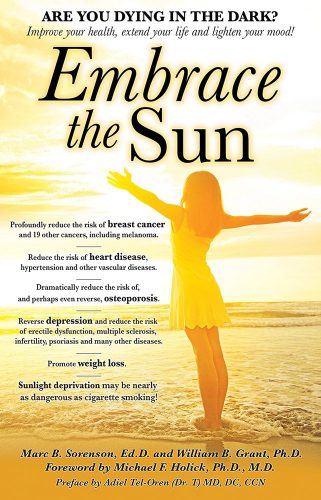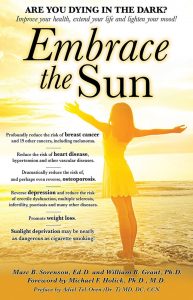Mental illness: Vitamin D deficiency, and thereby sunlight deficiency, plays a major role. By Marc Sorenson, EdD.
Mental illness is a pandemic in the United States. Nearly one in five U.S. adults live with a mental illness (46.6 million in 2017). Mental illness has multiple causes and manifestations. It is especially relevant to understand that sunlight deprivation, leading to vitamin D deficiency, plays a major role in this disorder. It is also important to realize that sun exposure, for typical people, produces about 90% of serum (blood) vitamin D. In addition, this production occurs when midday sunlight touches the skin. However, vitamin D is only one of several photoproducts produced by sun exposure to skin or other body parts. In addition, sun exposure produces serotonin, endorphin, dopamine, and brain-derived neurotropic factor (BDNF). Furthermore, all of these vital chemicals has a profound influence on mental Illness.
An important study on vitamin D
The disease is ubiquitous, as is sun deprivation. Thus, thus an investigation on vitamin D and mental illness reminded me of the affects of sunlight. This laboratory-based study found a high prevalence of vitamin D deficiency among 290 patients with mental illness. Consequently, Only 18% of these patients showed adequate levels of vitamin D. To me, this also means that only 18% were obtaining sufficient sun exposure for good mental health and well-being. The researchers concluded that sensible sun exposure could be a boon to mental health.
Let us now discuss a few of the disorders classified as types of mental illness. Then we will also mention the research that indicates an impressive salutary influence of sun exposure.
ADHD, a mental illness of children
ADHD ( attention deficit hyperactivity disorder) is the most prevalent of all mental disorders in children. Hence, it causes significant problems with executive functions, leading to hyperactivity or impulsiveness not appropriate for the person’s age.
Researchers have found that sun exposure correlates to a decreased risk of ADHD. They assessed the relationship between the prevalence of ADHD and the intensity of the sun in various nations and in US states. And after adjusting for birth weights, infant mortality and other relevant factors, the findings were not altered. It was obvious that sun deprivation by itself was associated with a higher risk of ADHD.
Autism, another disease of youth
Is autism a sun-deficiency disorder? Autism rates are increasing exponentially and associate to vitamin D deficiency, which, of course, associates to sun deficiency. The Autism Society of America defines autism as “a complex developmental disability typically appearing during the first three years of life and is the result of a neurological disorder affecting the normal functioning of the brain, impacting development in the areas of social interaction and communication skills. Both children and adults with autism typically show difficulties in verbal and non-verbal communication, social interactions, and leisure or play activities.”
If vitamin D deficiency and/or sun deprivation relates to autism, symptoms should improve in summer. Thus, a case study reported by Dr. Cannell revealed improvements in autism-related sleep and behavioral problems during summer. Autistic traits such as crying, excitability, hyperactivity and pounding objects profoundly diminished during summer.
Bipolar Disorder
Bipolar disorder (BPD), also known as manic-depressive illness, is a brain disorder causing unusual shifts in mood, energy, activity levels, and the ability to perform day-to-day tasks. Symptoms are severe and can result in damaged relationships, poor job or school performance and even suicide.https://www.nimh.nih.gov/health/topics/bipolar-disorder/index.shtm
Sun exposure resets the body’s circadian rhythms, which are variations in physiology and behavior persistent with a cycle length close to 24 hours. This system is contained in the hypothalamus and stimulated by nerve cells in the retina of the eye in response to light. Research indicates that environmental conditions early in life may imprint the circadian system and influence mental function later in life: Increased number of hours of daylight at the location of birth during the first three months of life are associated with a significantly older age of onset of bipolar disorder. For a longer discussion on bipolar disorder, read the book, Embrace the Sun.
Cognitive disabilities (intellectual disorders)
Another research study, based on a 15-year residential history of varying degrees of sun exposure, produced an interesting result. It showed that cognitive impairment in persons who were below the median exposure to sunlight was 88% greater than in those who were above the median. These same investigators had previously shown that lower levels of sun exposure resulted in a 2.6-times higher incidence of cognitive impairment. Therefore, if you want to think clearly and keep your marbles, regularly soak up some non-burning sunlight.
Depression
Few people realize how prevalent depression is in our society, a mental illness representing a huge drain on the economy. Moreover, according to Steven Genuis, in an editorial in Canadian Family Physician, “The World Health Organization estimates depression costs the American economy about $44 billion annually, equal to the total cost of all cardiovascular diseases.” He also stated that in one decade, there was a 300% increase in the sales of antidepressants, making these medications the top-selling pharmaceuticals in the world. (Genuis, S. Keeping your sunny side up (editorial). Canadian Family Physician 2006:52:42-43.)
So what does the sun do to relieve “the blues?”
The answer probably lies in a chemical responsible for transmitting impulses between nerve cells. This “neurotransmitter,” serotonin, is a natural “upper,” and works in synchronization with the natural “downer,” melatonin. When we awake to sunshine, light enters the eye and stimulates serotonin production. We then quickly become awake and invigorated, and melatonin diminishes. Nevertheless, at day’s end, the bright light disappears (or at least it should), melatonin levels rise, and serotonin levels diminish. We begin to feel sleepy and ideally retire for a good night’s rest. It is a perfect system for our needs—unless we stay up beyond biologically natural hours, by using artificial lighting. Many experts believe that lack of serotonin is a cause of depression.
The most important study on serotonin
Though I mentioned this study in my previous blog on sunlight and depression, it bears repeating here. Dr. Gavin Lambert performed one of the most important and unique studies on serotonin. He and his colleagues measured serotonin levels in response to varying degrees of sunlight. First of all, they drew blood samples from the internal jugular veins of 101 men. In addition, they compared the serotonin concentrations of the blood to weather conditions and seasons. As a result, men measured on a bright day produced eight times more serotonin, than those measured on a dismal day. Of course, the mood improved due to sunlight, with no involvement whatsoever of vitamin D. Thus, regular, non-burning sun exposure is the answer to depression. In addition, remember that sun exposure also leads to the production of other mood enhancers such as nitric oxide, endorphin and dopamine.
Certainly, sunlight deprivation is not the only cause of mental illness, but it is one of the most important.
There are more mental illnesses to discuss, and I will expatiate on those in a future article. In the meantime, protect your mental health by being sure to obtain your share of non-burning sunlight. For more information, visit sunlightinstitute.org, and read the book, Embrace the Sun.

Children’s diseases associated with sun deprivation. by Marc Sorenson, EdD
Children’s diseases that are associated with sun deprivation are legion. So, how do I know this? Because my last five blogs discussed this topic, and I’m a long way from finishing the theme.
To subject our children to sun deprivation is child abuse. It results in either lifelong or temporary children’s diseases.
So, the first of the children’s diseases discussed this week will be acute lower respiratory infections (ALRI). In addition, the second will be attention deficit hyperactivity disorder (ADHD).
ALRI are a leading cause of sickness and mortality both in children and adults worldwide. Furthermore, ALRI are not uniformly defined and this may hamper a true appreciation of their importance. Also, from an epidemiological point of view, the definition of acute lower respiratory infections includes other diseases. The most noteworthy of these diseases are acute bronchitis and bronchiolitis, influenza and pneumonia. The NCBI also states that acute respiratory infections, and particularly lower respiratory tract infections are deadly. Another fact is that these diseases are the leading cause of death among children under five years of age. Especially relevant is that they are estimated to be responsible for between 1.9 million and 2.2 million childhood deaths globally.
Studies regarding children’s diseases indicate that sun exposure has protective effects, whether due to vitamin D production or another factor.
First of all, in one study, children placed outside in sunlight were less than half as likely to suffer ALRI. Another investigation on sunlight compared vitamin D levels and sun exposure habits in children with and without ALRI. And, there was virtually no difference in vitamin D levels between the sick and healthy groups. Yet, those children who had a higher percentage of the body exposed to sunlight were less likely to have ALRI. Therefore, this reinforces the fact that sun exposure has preventive effects beyond vitamin D for children’s diseases.
ADHD (attention deficit hyperactivity disorder) is another of the disheartening children’s diseases.
ADHD is the most prevalent of mental disorders in children. And, it causes significant problems with executive functions (e.g. attentional control and inhibitory control). In addition, it causes attention deficits, hyperactivity, or impulsiveness not appropriate for a person’s age. Thus, it is certainly another of the important children’s diseases. Also, researchers have found that sun exposure correlates to a decreased risk of ADHD. The investigators assessed the relationship between ADHD prevalence and sun intensity in various nations and in US states. As a result, they found a close association between low sunlight intensity and the prevalence of ADHD. Another finding was that it explained 34%–57% of the variance in ADHD prevalence, with high sunlight intensity having a preventive effect.
It seems like the advice to deprive our children of sun exposure, in order to a prevent melanoma, is disastrous. Do we want to increase the chance of ALRI, ADHD or other children’s diseases we have already discussed? In conclusion, let’s love our children and be sure that they receive plenty of regular, non-burning sun exposure. And for more information, read the book, Embrace the Sun.
Happy sunning!

It is interesting that the authors suggested that that the mechanism by which sunlight accomplishes this improvement could be a positive change in the circadian rhythm, a factor that had previously been associated with ADHD. It was also interesting that the researchers did not mention vitamin D production by sunlight, since several studies have shown an association between low vitamin D and diseases such as Alzheimer’s, brain development in baby rats, autism, anxiety and depression. Rats born to vitamin D deficient mothers also have permanently damaged brains into adulthood,[2]and exhibit hyperactivity.[3]In addition, recent research shows that adult vitamin D deficiency leads to behavioral and brain alterations in mice.[4]
Considering the aforementioned effects of vitamin D deficiency on the brain, it is not surprising that sunlight, which stimulates the skin to produce vitamin D, correlates to a reduced risk of ADHD. It is a mystery that the authors did not consider vitamin d production as the mechanism that leads to the improvement.
Let’s soak up some sunlight, get rid of hyperactivity and start focusing on those things that are important—a good idea for both children and adults!
[1]Martijn Arns, Kristiaan B. van der Heijden, L. Eugene Arnold, and J. Leon Kenemans. Geographic Variation in the Prevalence of Attention-Deficit/Hyperactivity Disorder: The Sunny Perspective. Biol Psychiatry 2013;15;74:585-90.






